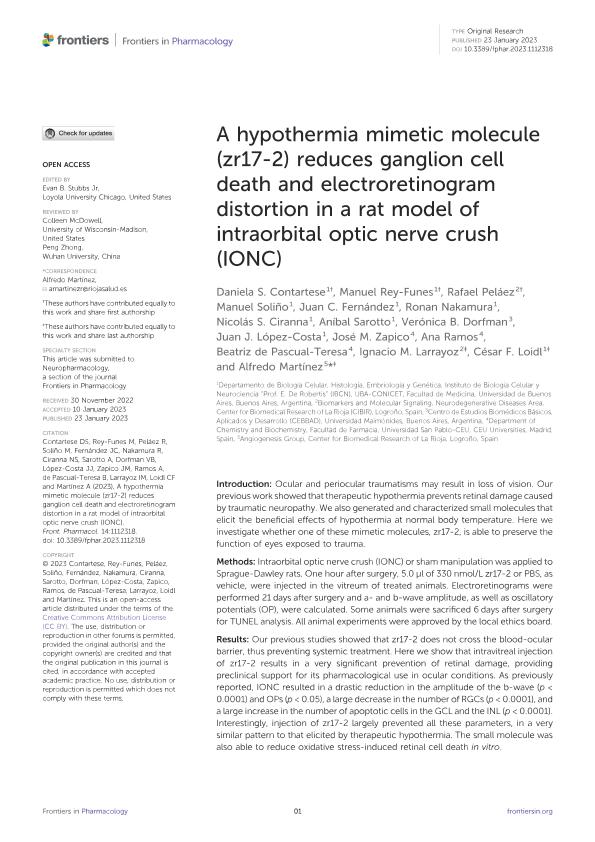Artículo
A hypothermia mimetic molecule (zr17-2) reduces ganglion cell death and electroretinogram distortion in a rat model of intraorbital optic nerve crush (IONC)
Contartese, Daniela Soledad; Rey Funes, Manuel; Peláez, Rafael; Soliño, Manuel; Fernández, Juan C.; Nakamura, Ronan; Ciranna, Nicolás S.; Sarotto, Aníbal; Dorfman, Verónica Berta ; López Costa, Juan J.; Zapico, José M.; Ramos, Ana; Teresa de Pascual, Beatriz; Larrayoz, Ignacio M.; Loidl, Cesar Fabian
; López Costa, Juan J.; Zapico, José M.; Ramos, Ana; Teresa de Pascual, Beatriz; Larrayoz, Ignacio M.; Loidl, Cesar Fabian ; Martínez, Alfredo
; Martínez, Alfredo
 ; López Costa, Juan J.; Zapico, José M.; Ramos, Ana; Teresa de Pascual, Beatriz; Larrayoz, Ignacio M.; Loidl, Cesar Fabian
; López Costa, Juan J.; Zapico, José M.; Ramos, Ana; Teresa de Pascual, Beatriz; Larrayoz, Ignacio M.; Loidl, Cesar Fabian ; Martínez, Alfredo
; Martínez, Alfredo
Fecha de publicación:
01/2023
Editorial:
Frontiers Media
Revista:
Frontiers in Pharmacology
ISSN:
1663-9812
Idioma:
Inglés
Tipo de recurso:
Artículo publicado
Clasificación temática:
Resumen
Introduction: Ocular and periocular traumatisms may result in loss of vision. Our previous work showed that therapeutic hypothermia prevents retinal damage caused by traumatic neuropathy. We also generated and characterized small molecules that elicit the beneficial effects of hypothermia at normal body temperature. Here we investigate whether one of these mimetic molecules, zr17-2, is able to preserve the function of eyes exposed to trauma. Methods: Intraorbital optic nerve crush (IONC) or sham manipulation was applied to Sprague-Dawley rats. One hour after surgery, 5.0 µl of 330 nmol/L zr17-2 or PBS, as vehicle, were injected in the vitreum of treated animals. Electroretinograms were performed 21 days after surgery and a- and b-wave amplitude, as well as oscillatory potentials (OP), were calculated. Some animals were sacrificed 6 days after surgery for TUNEL analysis. All animal experiments were approved by the local ethics board. Results: Our previous studies showed that zr17-2 does not cross the blood-ocular barrier, thus preventing systemic treatment. Here we show that intravitreal injection of zr17-2 results in a very significant prevention of retinal damage, providing preclinical support for its pharmacological use in ocular conditions. As previously reported, IONC resulted in a drastic reduction in the amplitude of the b-wave (p < 0.0001) and OPs (p < 0.05), a large decrease in the number of RGCs (p < 0.0001), and a large increase in the number of apoptotic cells in the GCL and the INL (p < 0.0001). Interestingly, injection of zr17-2 largely prevented all these parameters, in a very similar pattern to that elicited by therapeutic hypothermia. The small molecule was also able to reduce oxidative stress-induced retinal cell death in vitro. Discussion: In summary, we have shown that intravitreal injection of the hypothermia mimetic, zr17-2, significantly reduces the morphological and electrophysiological consequences of ocular traumatism and may represent a new treatment option for this cause of visual loss.
Archivos asociados
Licencia
Identificadores
Colecciones
Articulos(SEDE CENTRAL)
Articulos de SEDE CENTRAL
Articulos de SEDE CENTRAL
Citación
Contartese, Daniela Soledad; Rey Funes, Manuel; Peláez, Rafael; Soliño, Manuel; Fernández, Juan C.; et al.; A hypothermia mimetic molecule (zr17-2) reduces ganglion cell death and electroretinogram distortion in a rat model of intraorbital optic nerve crush (IONC); Frontiers Media; Frontiers in Pharmacology; 14; 1-2023; 1-10
Compartir
Altmétricas



